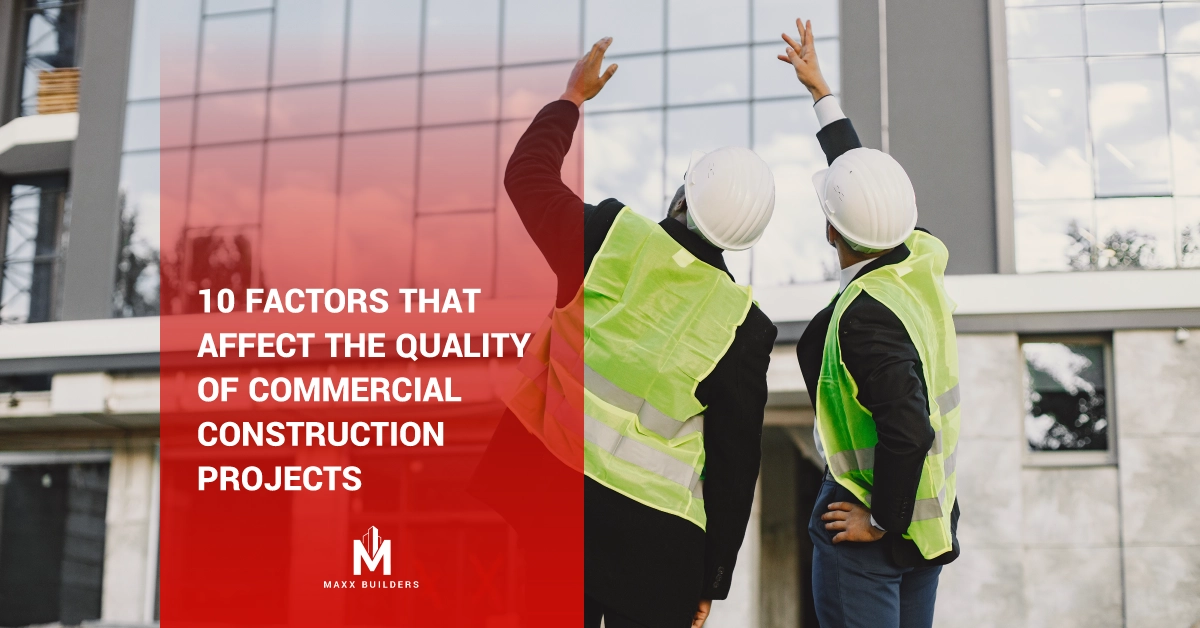1. Damaged and Low-Quality Materials
The water/sand ratio is incorrect in a concrete mix, lumber cut from undersized trees and improperly graded steel can all result in significant construction quality issues. Not only do these materials fail early, they also create construction safety hazards by reacting unpredictably during the building process. Workers are often hurt when sparks are generated during cutting when they’re not expected or as a structure collapses due to a lack of weight-bearing ability. Ordering only from trusted suppliers and ensuring the superintendent checks every shipment of materials is the only way to verify a project is properly supplied. Maxx Builders QA/QC plan holds the superintendent responsible to check the material with a checklist.
2. Supplier and Vendor Failures
Even when the materials themselves aren’t the cause of a quality issue, problems with suppliers and vendors can raise costs and lower quality levels. Replacing the requested building supplies with other brands and materials that don’t offer the same quality can result in unsatisfied clients and time-consuming rework requests. Set clear expectations with all suppliers and perform random checks to verify they’re still adhering to the contract. Finding new vendors may feel like a distraction in the middle of a construction project, but it can significantly improve construction quality management.
3. Subcontractor Mishandling
According to some studies, over 50% half of construction defects can be attributed to human error. If a subcontractor hires employees without the right skills and fails to train them, workmanship errors occur that can go unnoticed for years. Screening subcontractors and other labor providers is essential to verify they’re supplying skilled laborers that can catch their own mistakes. However, construction firms and project managers still need to follow up with independent audits of subcontractor performance to find any problems as early as possible. Maxx Builders has an extensive qualification that subcontractors must go thru to be awarded a project.
4. Failure to Document Changes and Practices
Some quality issues aren’t directly related to a mistake or design change, but rather to the lack of documentation of the change. If a material is substituted for another with a completely different maintenance and replacement cycle, failure to update the final documents can result in improper handling from the maintenance team. Use a digital file management system that simplifies the process of updating project documentation so that there’s no reason to delay updates to drawings and other related files. Maxx Builders’ cloud-construction management technology has streamlined documentation.
5. Last-Minute Changes
When essential features are still being engineered or discussed at late stages in the construction process, these last-minute changes often lead to serious quality issues. Setting deadlines by which designs can’t be altered anymore or make arrangements to extend the deadlines and set aside plenty of time for verifying and testing any changes to the existing designs.
6. Scope Creep
Construction projects often start out much simpler and smaller than the finished project. So how does a basic bridge or retail center turn into a multi-lane highway or a three-story mall? This kind of unplanned expansion is often referred to as scope creep. While it’s natural for all projects to change with time as new facts are discovered about costs, time constraints, and site limitations, the problem comes when the expansion in scope leads to cutting corners to stretch a limited budget and time frame. Managing the scope of a construction project ensures the contractors can maintain the same level of quality over the entirety of the work.
7. Miscommunication Between Teams
Studies of the construction industry has found showing project managers feel that communication issues are the number one cause of quality issues. Miscommunication leads to the misapplication of new techniques, mismatched materials, and a lack of secondary and tertiary testing to discover existing problems. Tools like Procore used by Maxx Builders are ideal for increasing communication between all of the various teams working together on a single construction project.
8. Complexity of Designs
Unnecessary complexity is the enemy of high-quality work. While some level of complexity is unavoidable in cutting-edge infrastructure and commercial construction projects, designers should minimize complex techniques and unusual features whenever possible. Simplified designs are also more affordable, offering the construction firm a better profit margin even while they’re producing the highest quality work.
9. Lack of Project Management System
A project management system determines the ideal intervals for testing the work completed so far for errors and omissions. Without a management system or plan for quality control and assurance, most construction firms wait far too long to perform essential checks on their work. Implementing a project management system based on mobile apps is a flexible and fast way to bring current projects under control.
10. Ignored Audits and Testing
Some construction companies stick strictly to their third-party testing and auditing plans, yet ignore the results of the tests and continue on with flawed designs or existing quality issues. This is often due to a lack of proper designation for quality control, causing reports to bounce from project manager to lead engineer without a clear workflow for addressing the material. Determine who’s responsible for reading the audit and test reports and making recommendations for rework or repairs to the contractors so that important information on quality issues isn’t overlooked.



